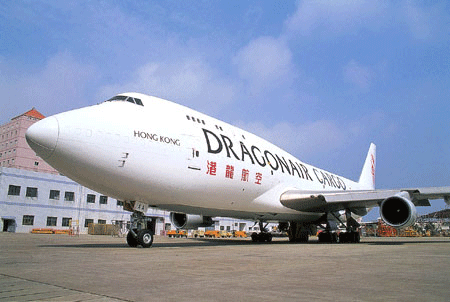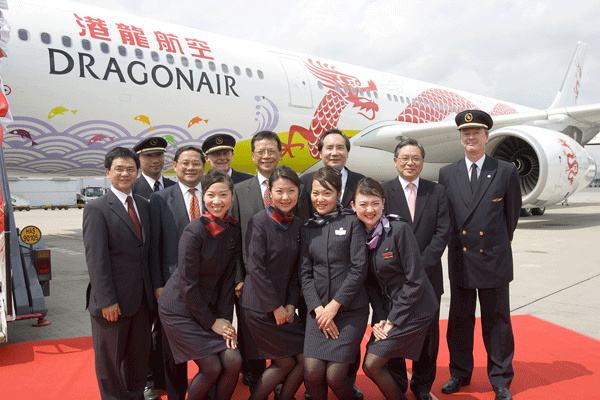Dragonair
Cargo Bullish On Hong Kong

Exclusive interview with Qiu Changxian (Albert Yau)
General Executive of Dragonair Cargo
 Seems that almost every day there is another
story of a Mainland China gateway project abuilding.
Seems that almost every day there is another
story of a Mainland China gateway project abuilding.
All this activity in places from Shenzhen
to Shanghai prompts some visionary types in transportation to predict
an eventual end to Hong Kong as the dominant gateway
But don’t try and put that theory
past Albert Yau, top manager for up and coming Dragonair Cargo.
In a wide ranging and up-front off the shoulder
discussion with FlyingTypers China Bureau Chief Han Bing, Mr.
Yau lays it on the line about everything from getting better two-way rates
to Dragonair Cargo’s long term plan:
“Hong Kong is an important transfer
place for air cargo to and from China’s mainland.
“Estimates in fact put the number
at about three fourths of all air cargo exported in China are transferred
through Hong Kong.
“Moreover China’s domestic airlines
have less than 20 all-cargo airplanes.
“So a large portion of China’s
air cargoes have to be transferred through Hong Kong, Singapore and Incheon
(Seoul) in South Korea.
“However,” Mr. Yau said, “airlines
operating Pan-Pacific routes face a common difficulty.
“That is the insufficiency of back
haul.
“Due to the severe imbalance of the
trade between America and Asia, export volumes from Asia to America far
exceed those from America to Asia.
“Load factors of airplanes from Hong
Kong to America are routinely 80 to 100 percent, while back haul is often
less than 50 percent.
“The imbalance is reflected in the
rates.
“Take the air course from Hong Kong
to the east-coast of America for example.
“Rates of freight to USA hit 28 HK
dollars per kilogram in prime-time last year, while the rate back to Hong
Kong was as low as 3.12 HK dollars.”
“Airlines are trying everything to
avoid loss on the back haul.
“Even a 50 percent back haul-rate
is enough to cover the cost, while 60 to 70 percent would be satisfying
for most airlines.
“So Dragonair is dedicated to pursuing
a workable back haul.
“We will rely on two points.
“First we have moved to ensure that
no further decline of rates on the back haul is allowed.
“Fortunately, this initiative has
been widely accepted by major airlines.
“Second point is that we must increase
the load rate.”
Currently, China’s domestic air cargo
market is experiencing rapid expansion, with an annual growth rate 2.4
times as high as the world average.
The nations exporting air cargo from Asia
across Pacific, China’s share has increased from 2.1 percent in
1983 to 25 percent in 2004.
Today China air cargo volume by comparison
is about the same as Japan.
But because of China continuous growth of
trade, in the near future, China’s share will exceed that of Japan.
Driven by China’s rapid growth, air
cargo rates from North America to Asia will increase by 7.3 percent in
the coming years.
“Dragonair Cargo has its own advantages
compared with other airlines.
“It has a giant air network in China’s
mainland, and uses Hong Kong as its base.
“For the shipper, Dragonair is more
efficient in transferring air cargoes from the Pearl Delta and the Yangtze
Delta to the world.”
Dragonair Cargo has seen substantial
growth in both capacity and tonnage uplifted in recent years.
The establishment of a dedicated cargo
fleet that includes three Boeing 747-300SF freighters, one Boeing 747-200F
freighter and one Airbus A300B4 has boosted cargo capacity at the carrier
significantly.
By the numbers Dragonair carried a
total of 270,000 tons in 2003, a 39.1% increase over 2002.
 First
there was the “bunny dip” now comes the “flight
attendant “stoop down”? First
there was the “bunny dip” now comes the “flight
attendant “stoop down”?
Come to think of it, what other industry in the world has pictures
taken like this?
Maybe that’s why we love transportation people.
Airlines in particular are show business.
Airplanes taking off and landing are exciting and fun.
Great companies like Dragonair reflect the excitement and pass
it along.
But the girls must have hoped the photographer would get the picture
in one shot as the Dragonair “20th Anniversary Aircraft,”
an Airbus A330 with sensational, ebullient art work that includes
466 stencils in eight colors, arrived in Hong Kong earlier this
year.
Dragonair CEO Stanley Hui in the center of things here said:
“It is the first aircraft in Dragonair’s history to
sport a special livery, and also has some stunning new features.”
The A330 is the 29th passenger aircraft in Dragonair’s fleet.
“The livery image embodies the spirit of the Chinese dragons
of old – a spirit that aspires to excellence. “Dragonair
carries on that spirit today in the passion we have for serving
our customers.
“It is a fabulous aircraft both on the outside and on the
inside,” Mr. Hui said, “ and our passengers love flying
in it.”
Founded in 1985, Dragonair operates a fleet of 12 A330-300s, six
A321s and 11 A320s, in addition to four Boeing 747-200/-300 freighters,
a wet-leased A300B4 freighter plus a wet-leased Boeing 747-400
freighter.
The airline's passenger network covers 31 destinations across
the Asia-Pacific region, while its cargo network connects the
markets of Europe, the Middle East, the United States, Japan,
Taiwan and China Mainland.
More www.dragonair.com.
|
This year the numbers are
even more impressive. Dragonair flew 3,692,930 passengers in the first
three quarters of the year, a jump of 11% over the same period last year,
while air cargo shipments climbed 15.8% to 278,301 tons in the first nine
months of the year when compared with January-September 2004. "This
is very healthy growth given the general background against which we have
been operating," said CEO Stanley Hui.
"We are facing greater competition,
higher operating costs mainly due to oil prices and a recent period of
bad weather, so the performance to date is very pleasing.
"Many of those factors will persist
into the fourth quarter - especially the pressure from high oil prices,
which appear to be having a dampening effect on travel - but we remain
cautiously optimistic about the coming months and the year as a whole
in terms of headline numbers."
Cargo posted a 6.0% rise month-on-month
during September 2005 to 33,769 tons, while year-on-year growth was basically
unchanged, at -0.2%.
"September is traditionally a better
month than August for freight, and so it proved, although a few technical
issues with aircraft during the month meant the level of shipments we
carried was not a true reflection of the demand in the market for our
services.
"Despite this, our New York route did
particularly well, driven by demand for Asian exports in the U.S. market.
"We remain optimistic about the coming
months, which are usually a busy time for air shipments."
Dragonair Cargo is now one of the major
revenue sources for the airline, accounting for a significant portion
of total company turnover.
Dragonair all-cargo operations have grown
rapidly since they were inaugurated in the summer of 2000. The airline
now operates scheduled freighter services between Europe, the Middle East,
Japan, Mainland China and Taiwan and its Hong Kong hub.
Seven weekly intercontinental flights serve
Dubai, Amsterdam, Manchester Stansted and Frankfurt
Meanwhile, Osaka is served by two flights
and Taipei is served by three flights a week.
Shanghai also has six weekly flights, three
of which offer co-terminal services to Xiamen.
Nanjing is served by one weekly flight.
At the end of July 2004, Dragonair Freighters extended the service to
Dubai, Stansted and Frankfurt.
“Hong Kong’s role as a major
transfer airport for the air cargo business in China will continue to
strengthen in the future, rather than weaken.
That growth and ongoing strength of market
will support our air cargo business in the long term and the development
of Dragonair.”
(Han Bing)
|



